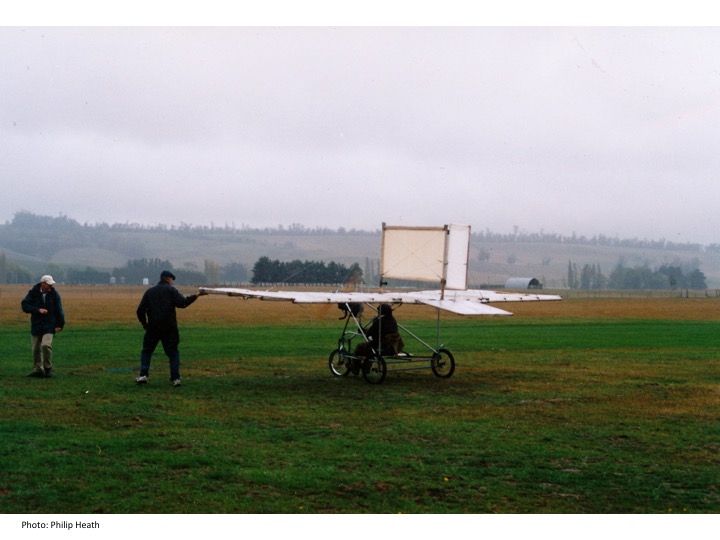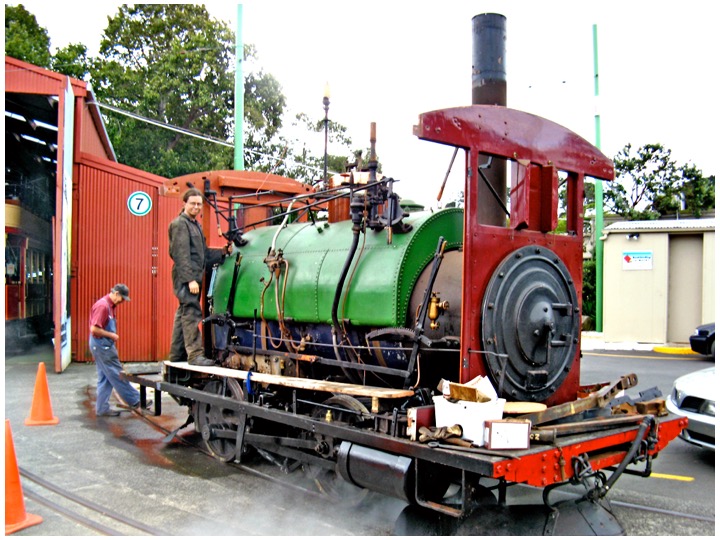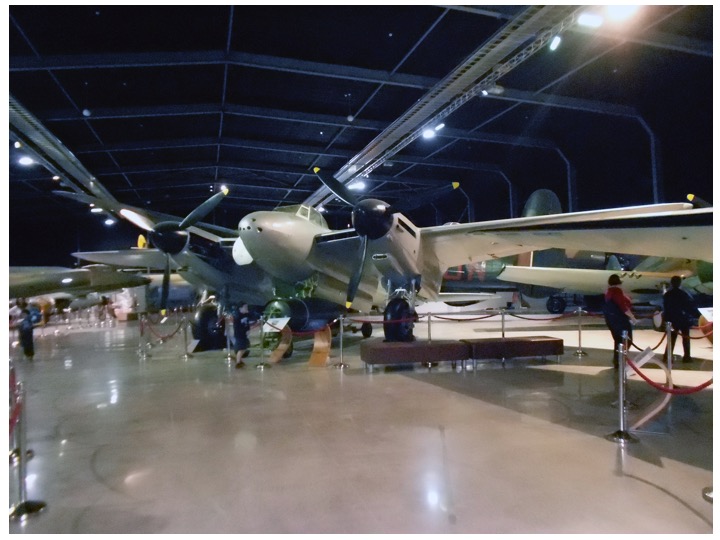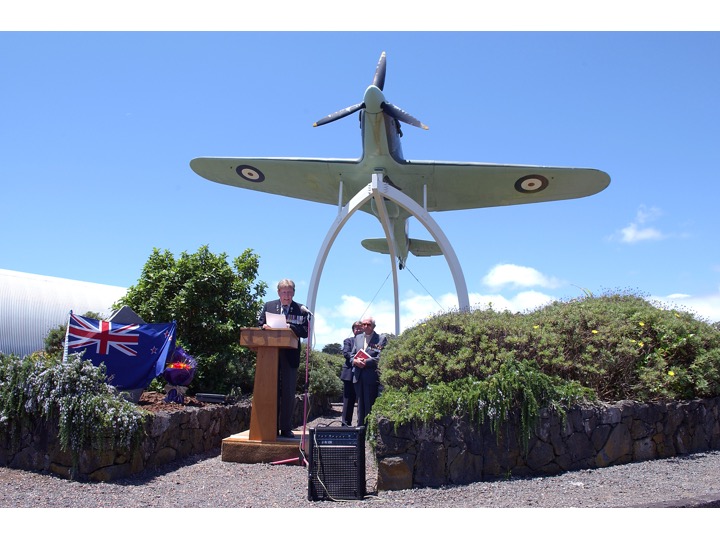The heading says it all:– the marvelous restoration projects of the MOTAT volunteers in the early days.
This article was originally prepared as a PowerPoint presentation for the Pakuranga Probus Club at the request of Don Fleming, a senior RNZAF engineer who was the backbone of the MOTAT Centenary of Flight 2003 Pearse Project with Geoff Rodliffe.
Pearse Project
The images show the MOTAT team at Timaru/Waitohi. 1. Project Team – Geoff Rodliffe, Rose, Don Fleming, and Phillip Heath, 2 &3. Jack Melhopt on the ground runs at Waitohi, 4. The replica Pearse engine.
Richard Pearse was an inventor/farmer living at Waitohi, near Temuka, who was experimenting with flying machines and built an aircraft that was reputed to make a short flight in March 1903, nine months before the American Wright brothers flew in the US in December 1903 recognised historically as the first flight.
MOTAT had acquired a number of artefacts from Pearse’s attempts and was internationally recognised for their involvement. Geoff Rodliffe, an aviation historian, wrote a book about Richard Pearse and his activities focusing on this early flight. The question of who flew first was debated internationally, and for the Centenary of Flight celebrations in 2003.
Geoff Rodliffe in conjunction with MOTAT and the MOTAT Society under the auspices of Don Fleming, a retired senior RNZAF engineer, built an operating replica. The machine was based on Pearse’s designs and was intended to fly, albeit with a modern microlight engine. An operating replica of Pearse’s engine was also built as a companion exercise.
A major national Centenary of Flight celebration was held in Timaru in March 2003. A key feature was the attempt to fly the replica, registered as ZK-RWP, on the Civil Aviation Register, at the Pearse farm at Waitohi. It was piloted by an experienced microlight pilot, Jack Melhopt who went through a significant number of test runs.
Unfortunately, on the actual day, the weather was very poor with much of the flying display cancelled. ZK-RWP was restricted to ground runs only although the potential for lift-off was very real.
ZK-RWP was then taken to London with Geoff Rodliffe and Don Fleming and displayed at the official Royal Aeronautical Society’s official Centenary of Flight celebrations in December 2003.
It is a major MOTAT story and the debate of who flew first still continues.
Wanganui Baldwin Tram 101
The Wanganui tram restored by the Tramways volunteers in three stages of its restoration.
I understand the tram was purchased and brought to MOTAT by the Stewarts.
Wellington Tram 47
Derelict to final state.
Mosquito
The Mosquito was purchased from a farmer in Marton in 1967 in a completely derelict state.
, and was one of several aircraft restored by the MOTAT Aviation volunteers under the direction of Norm McKelvie, a senior Air NZ engineer, who also worked with Mosquitos in the Territorial RNZAF.
The airframe is basically wooden with the exception of the wing section and the blending of the two components was a particularly delicate operation.
FAI Award
Slide 17 is Section Head Norm McKelvie and Mr Adams with the award
Slide 18 is the Aviation Section volunteers besides the Sunderland with the award.
MOTAT Aviation was awarded the Diplome d’Honneur of the Federation Aeronuautique Internationale (FAI) of Paris in recognition of the excellence of the heritage aircraft restoration work carried out at MOTAT, and the contribution to the preservation of aviation heritage internationally.
Norm McKelvie was later also awarded the QSM for services to heritage aviation at MOTAT
Flying Boats
The two flying boats the RNZAF Sunderland, and the ex-TEAL Short Solent especially, are key
MOTAT Aviation artefacts. The Solent was basically restored by a team of ex-TEAL/Air New Zealand engineers, air and cabin crew who flew and maintained the aircraft during the 1950s and built an in-depth Air New Zealand heritage display including oral histories of that era.
The aircraft were floated across the harbour, pulled out at Meola creek and hauled across Meola Rd to MOTAT 2 which was then a closed rubbish tip. It sat there for many years before the first display hangar was built by the Bomber Command and Fleet Air Arm veterans group assisted by the Air NZ team.
RNZAF WWII 1945 Rabaul Incident Brian Cox
Slide 22 is a painting of the Rabaul incident with Brian Cox’s Corsair featured.
Slide 23 is Brian Cox speaking at the dedication
Slide 24 is the memorial itself with the rock the Society paid for
The RNZAF’s major loss in World War II was in an attack on the Japanese base at Rabaul in PNG from their base on Green Island in the Solomon Islands in January 1945. F/L F O’Keefe was shot down and parachuted into Rabaul Harbour. In subsequent attempts to rescue him, seven pilots from No 14 and No 16 Squadrons got lost in a tropical thunderstorm and didn’t return to base. Brian Cox, a 14 Squadron pilot, landed safely.
A US Navy veteran Marvin Birk who was at Green Island at the time, and the NZ Fighter Pilots Association with Brain Cox as President, initiated a memorial to the lost pilots at MOTAT alongside the Sir Keith Park Memorial Hurricane, supported by the MOTAT Society who donated the rock base. The Society placed flowers on the memorial on ANZAC Day for many years.
TEAL Volunteers Catalina Outing Slide 25

The Society often supports other heritage groups by organising events with them at full commercial rates to help their finances. This has included chartering the tug boat W.C.Daldy for a harbour cruise for members and other events.
This occasion features the chartering of a flight in the Catalina flying boat based at Ardmore for the old TEAL volunteers at MOTAT and included engineers, aircrew and cabin crew. A wonderful flight over Auckland, including over MOTAT and a special clearance to fly right over Auckland Airport back to Ardmore. The CAA people were very keen to see the vintage aircraft up close as well.
Newcomen Replica Steam Engine Slide 26

Thomas Newcomen built the first operational steam engine in 1712, and to recognise the 200 anniversary Ken Poynton and the Steam section volunteers and their Auckland Steam Engine Society built a working replica of Newcomen’s engine to be part of a MOTAT display. This unfortunately did not come to pass, but the engine is now based at the Steam Society’s Whangaparoa centre.
by Bill Rayner















































Comments